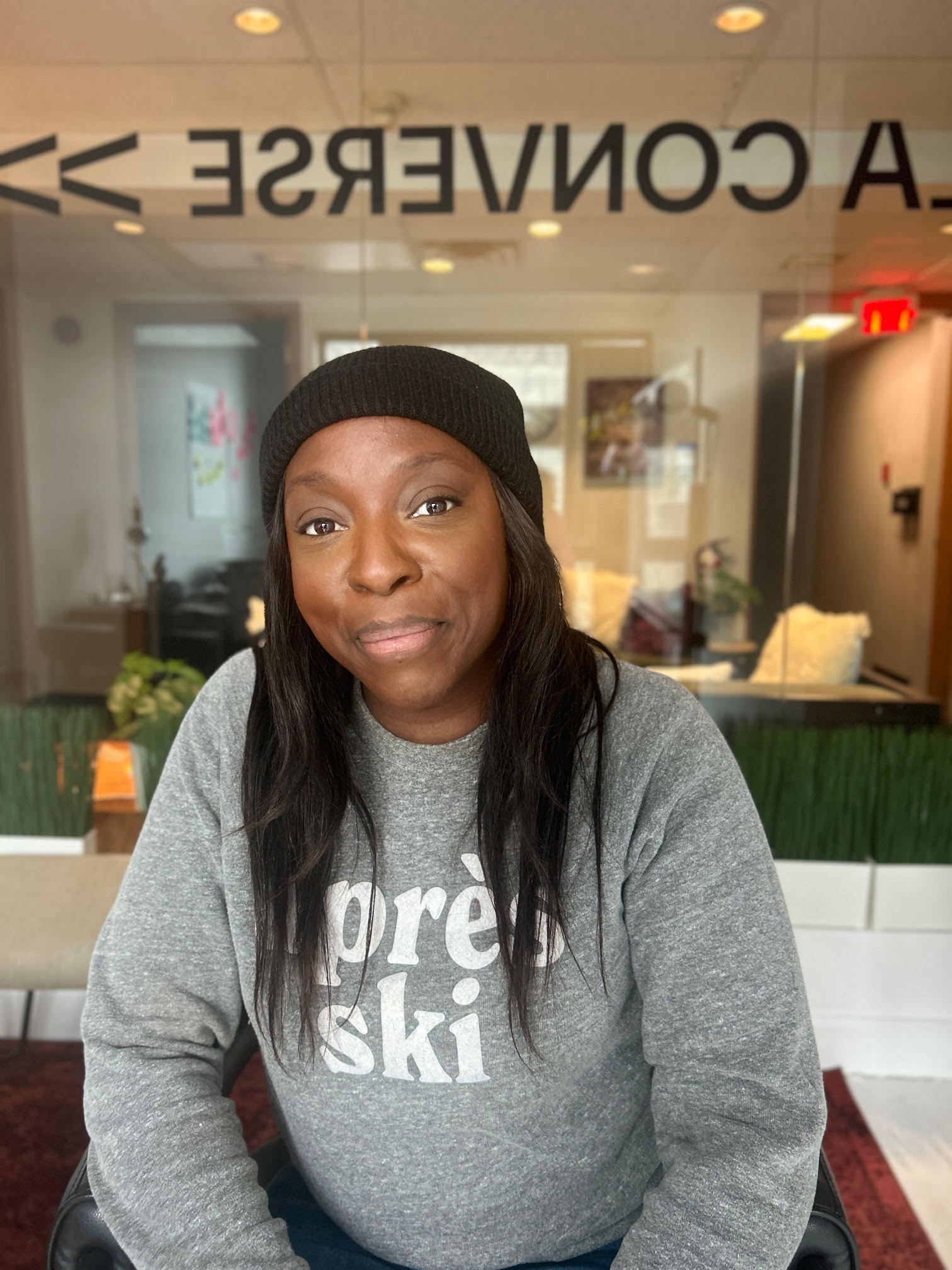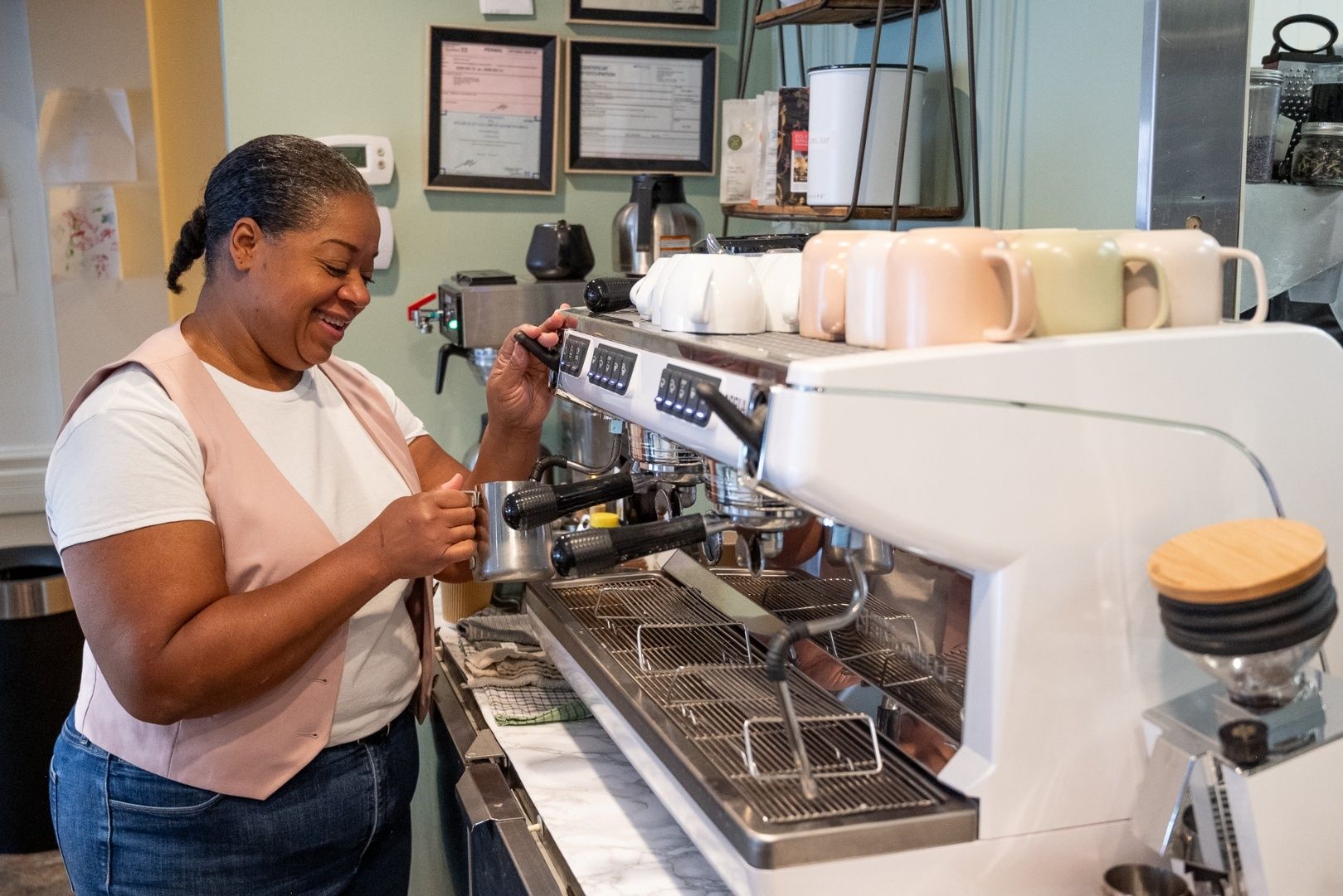We meet Niti Marcelle Mueth, co-founder of the community organization Learning Loop, at Café St-Henri in the Villeray neighbourhood to talk about Montréal-Nord and the project Le passé reste vivant . This new initiative will kick off on Saturday, July 12, with two more sessions scheduled for later this summer.
Latin American rhythms fill the space; La vida es un carnaval by Celia Cruz plays from the speakers like a musical manifesto: despite hardship, joy is an act of resistance. Niti speaks in a soft voice, her eyes lively, but her tone is resolute. She speaks of legacy, transmission, and healing wounds.
In less than 48 hours, she’ll be co-facilitating the first of several interactive workshops for youth in Montréal-Nord—a neighbourhood all too often reduced to stereotypes of violence, poverty, marginalization. But for those who live there, and especially for its youth, Montréal-Nord is so much more, Niti insists. She refuses the simplistic generalizations. “Realities are multiple, and so are the stories,” she says. “We tend to talk about working-class neighbourhoods as if they were one homogeneous block. But they’re not.”
It’s that fixed image she wants to challenge. When asked about Montréal-Nord’s reputation, Niti makes no attempt to hide her frustration or straightforwardness. For her, the real issue lies in perception. “Everything that comes from the outside is just that. A perception. Those people don’t know what it’s like to actually live here. And yet, so many beautiful things are happening.”
“Montréal-Nord is one of the most underserved areas in terms of access to cultural activities. It’s also fairly far from downtown. There’s a real need to offer young people opportunities they might not otherwise get compared to youth living closer to the city center. It gives them autonomy, but also shows them they can do anything with their lives.”
A visual artist and cultural mediator, Niti takes a clear stance in the spaces she facilitates. There is no judgment, no mission to “fix” anyone. “Even if I’ve worked with youth facing poverty, in the streets, or using drugs, my role isn’t to change their lives or tell them ‘what you’re doing is wrong.’ In the end, they’re doing what they need to do to survive.” Through these workshops, what she wants to offer is hope and the feeling of being seen and understood.
Niti grew up between Ahunstic and Pierrefonds, two neighbourhoods with distinct histories, though united by similar struggles. That dual experience shaped her belief: talking about working-class communities means telling not one story, but a mosaic of experiences and realities. She insists on that diversity to push back against reducing young people to a frozen image or a single, predictable path.
Three chapters to share history and imagine the future
The workshops in Le passé reste vivant are structured as a three-part journey designed by Learning Loop to explore Black memory through the lenses of past, present, and future.

The first session focuses on the history of Black communities in Québec, Montréal, and Canada. “We talk mainly about Black history so the youth can understand how and why they’re here,” Niti explains. The goal is to open the door to stories too often forgotten or silenced, helping youth place themselves within a living, collective memory.
The second session, taking place on July 19, will center on the present. “We’ll talk about how they feel today in society,” Niti says, “based on what they took from the first workshop and how they feel it impacts their lives now.” The event description poses the question: “How do we affirm our identities and collective strength in a system that seeks to divide us?” Niti emphasizes that young people shouldn’t constantly have to deconstruct stereotypes imposed on them. “It’s not necessarily Black people’s responsibility to break down an image we didn’t create. What matters more is recognizing our worth, knowing we’re doing what we need to do, but not to prove anything.”
The heart of this second session is to give youth a space to reflect, share, and build the tools they need to reclaim power over their collective story.
The final workshop, focused on the future, invites youth to imagine possible and desirable futures, an exercise that incorporates elements of Afrofuturism. This genre, blending Black culture, science fiction, and radical hope, invites reimagining the future by centering creativity, innovation, and the resilience of Black communities. The idea is “to imagine futures in which we thrive, where we’re free to do what we want.” It’s about dreaming up worlds where liberation and social justice are central. As Niti puts it, “It’s up to us to stand firm and know what we want.” This final session acts as a catalyst—a space for inventing new ways of being, creating, and acting.
The workshops will ultimately lead to the creation of collective or individual artworks, though what form they’ll take is still open. That intentional ambiguity reflects an essential freedom in which things emerge organically. What matters most is that these voices are present—carried, seen, heard, and felt. It’s a space for authentic expression, where young people can reclaim their narratives without filters.
“Often, when I work with youth, they tell me they don’t feel taken seriously by adults, or they’re not being heard. Their voices are just as important as anyone else’s.
Learning Loop: A Free Third Space to Create, Learn, and Reconnect
Learning Loop is rooted in the principles of popular and collaborative education as a vehicle for change. The organization is, first and foremost, the story of two sisters: Niti Marcelle Mueth and Taïna Mueth. One studied community health and psychiatry, the other art therapy and graphic design. Together, they co-founded a unique and free “third space” in 2022 designed for immigrant and marginalized communities to create, learn, and build connections in new ways.
“Our goal was really just to create opportunities for people, and to have a space where they can not only connect but also learn, share knowledge, and create for free.”
Learning Loop was born from an acute lack of such spaces. “There was really a gap in Montréal. (…) Most gathering spaces are paid or not really designed for connecting with your community,” Niti explains. She and her sister, who grew up in Ahuntsic and Pierrefonds, remember a childhood marked by the absence of community spaces. “Apart from school and home, there wasn’t really anywhere. We grew up in the church, so that was our community, but outside of that… we didn’t have much contact with Québec society.”
That hunger for belonging and free expression led them to organize monthly pay-what-you-can workshops—spaces that could serve as “refuges,” places where people come without needing to consume anything, “just to talk, create, and connect.”
For Niti, art is not a hobby. It’s a lifeline. “Art kept me alive. It’s what helped keep me grounded. (…) Even if it’s not art, just having something that grounds you a little, that really helps.”
In these workshops, art becomes a therapeutic tool and a way to break silences. “It’s a way to heal, to express yourself, but also to send messages, to be understood. There’s so much to art beyond just being beautiful.”
For the young woman of Haitian and Cameroonian descent, the work holds particular meaning in racialized communities, where mental health issues are still often underrepresented. “Especially in our community, because therapy and psychology are still somewhat taboo. I think that’s slowly changing, thankfully. But with everything we’ve lived through—intergenerational trauma—there’s so much to heal.”
She sees art therapy as a kind of catharsis. “Until we do the healing work, it just keeps going. People have health problems or mental health struggles and don’t even know where they come from.”
For the past two years, the two sisters have carried the project on a volunteer basis. “It’s a passion project. We don’t make money doing this. We do it because we believe in the impact it can have on a young person’s life.” Niti knows this firsthand. “I’ve seen how much art can change lives. It did that for me. That’s what I want to offer youth too.” For her, art opens up pathways. She talks about art that heals, that gives language to what can’t always be said. “It’s what helped me stay grounded.”
“My mom wasn’t very happy about me being an artist or studying in more artistic fields. I really had to fight for what I believed in. Today, I’m proud to show youth that it’s possible. That’s what it means, not to limit yourself.”
For Niti, it’s not necessarily about art itself, but about having something to hold onto. A space, an activity, a touchstone. Something tangible in the world that brings meaning, value, and a sense of autonomy and confidence. “Even if it’s not art, just having something that anchors them a bit—it really helps,” she says, grateful to have witnessed that power.
Through Learning Loop and other grassroots organizations like Hoodstock, a different vision of Montréal-Nord is emerging: one where solidarity, creativity, and collective memory nourish the futures ahead. Beyond the stereotypes, these initiatives remind us that the future of Montréal-Nord is already being written today through the solidarity, memory, and imagination of its youth.




.jpg)
.jpg)


.jpg)
%20(1).jpg)
.jpg)